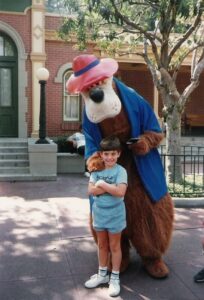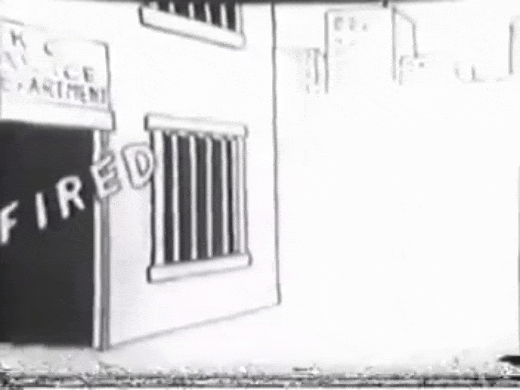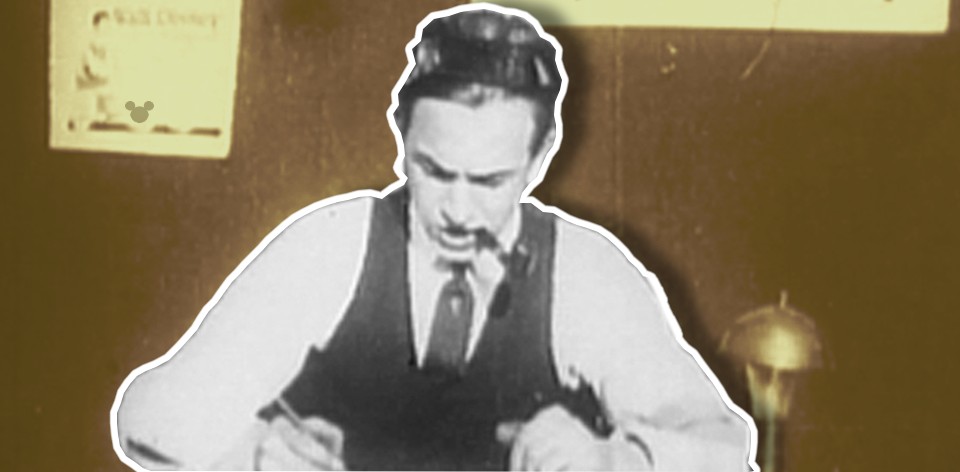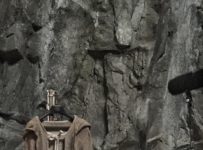Here I attempt to watch (almost) all of Disney’s output in the order it was released. We begin our Dis-covery in 1921 on the second floor of a building in Kansas City, Missouri.

Disney is now a global household name, a franchise machine that has dominated the global box office, streaming channels and merchandise worlds for the last few decades. Yet their beginnings were far less flashy.
My own early recollections of Disney come from the early 1980s, a period when Disney was putting out less than stellar product. In the long stretch between The Fox and the Hound (1981) and The Black Cauldron (1985), the studio was releasing a string of largely forgotten live action: Tex, Trenchcoat, Something Wicked This Way Comes don’t turn up on Disney+. While history, and this film fan, remembers Tron (1982) and Return to Oz (1985) fondly, neither performed well at the box office back in the day. This is the era of Disney I grew up in.

Brer Bear and pre-beard
Richard at Disneyland.
Photo credit: My mum
(April 1987).
Nevertheless, a lifelong fan of Disney emerged here in Sydney, Australia. This was partly due to the solid program of re-releasing ‘Vault’ titles and the emerging VHS market. One of my fondest memories is receiving a Bedknobs and Broomsticks video in the mid-80s, or watching edits of cartoons on The Wonderful World of Disney on a Sunday night on Channel 7. In 1987, I went to Disneyland for the first time and totally met Mickey Mouse.
Which is a long way of saying that over the years, I’ve regularly devoured the shorts and features of Disney from the 1930s onwards. Yet until recently, after rediscovering my old Disney Treasures DVD sets, I hadn’t really looked at Disney’s history as an entire entity. So I went back to the beginning.
This is what happens when #isolife amps up.

Walt Disney’s early life is well covered by countless books and a number of feature films, including As Dreamers Do (2014) and Walt Before Mickey (2015). After moving to Kansas City, Disney befriended fellow animator Ub Iwerks and answered a newspaper ad for a job in creating promos for the Kansas City Slide Company. A forerunner to Walt Disney Animation Studios, in 1921 Walt was contracted to do 12 short cartoons he called Newman’s Laugh-O-Grams. The following year, at the tender age of 20, he incorporated Laugh-O-gram Films (LOGF).
That studio (for want of a better word) that employed the likes of Iwerks, Hugh Harman, Friz Freleng, and Carman Maxwell worked on a number of commercial and artistic endeavours. A tumultuous few years led to their eventual bankruptcy and move to California, but a number of shorts were made out of the McConahay Building at 1127 East 31st in Kansas City. While the story today is that it “all started with a mouse,” in reality it started with a pilot newsreel that originally screened at Newman Theater.
“Walt built a makeshift camera in his garage at home,” claims his official museum biography. “These reels included both ‘lightning sketches’ – vignettes in which Walt’s own hand seemed to be sketching a detailed drawing at lightning speed – and some fully animated scenes.” Taken together, they are a series of comedic moments (or “illustrated jokes”) about life in KC at the start of the century.
The first surviving film produced by his Laugh-O-Gram Studio on the reel is CLEANING UP!!? (1921). It’s really live action film of Walt drawing a single cel of animation, a crook being booted out of town and told to ‘stay out.’ Apart from being a glimpse into how talent Walt was an an artist before he became a mogul, it’s also a glimpse at his actual hands and drawing style. “As one might have expected from a nineteen-year-old novice,” writes biographer Neal Gabler, the reel was “raw and unsophisticated, though competently drawn.”
KANSAS CITY GIRLS ARE ROLLING THEIR OWN (1921) is a similar piece, showing a fine expose on the length of stockings in the 1920s. After being told that stockings are so high now they have to be rolled down at the top, the apparently separate images coalesce into a storefront window. It’s not much, but we can see this as an early attempt are creating a sense of place through line art.
DID YOU EVER TAKE A RIDE OVER KANSAS CITY STREET ‘IN A FLIVER’ (1921)? The short answer, Walt, is no. No I have not. Yet now I feel like I have thanks to the simple art of film. Here you can totally see the style being developed that would go into character designs later in the decade. It’s certainly the most complete ‘scene’ from the very early Laugh-O-Grams.
Then we take a tiny leap in animation technology with the final surviving short from this reel. In KANSAS CITY’S SPRING CLEAN-UP (1921), a spiritual sequel to the first film, we see Disney sticking it to the police almost 100 years ago! One of the first fully animated pieces from Disney and Co, it’s a simple affair of a string of cops entering a building, being beaten up off-screen and booted back out with a shout of “Your fired.” Sure, “you’re” is misspelled here but I choose to think of this grammatical insult being hurled as a final middle finger to the fuzz who had apparently messed with KC citizens for the last time.

It’s still a single frame setup, but it’s positively teeming with life. While that frame is ostensibly static, look at the small differences in each of the cops. See how the building bulges and wobbles as if bursting at the seams. Look at the cartoon clouds coming out of the windows at they explode. Indeed, the animators could have saved time, ink and money by just throwing the police out the building. Instead, we get each object – hats, coats, bodies – thrown out one at a time. It is the start of what the company would later call the “illusion of life.” It’s also the beginning of storytelling in animation.
Only two years later Alice’s Wonderland, the first of the Alice Comedies, was released. Six years later, Trolley Troubles, the first of the Oswald the Lucky Rabbit shorts, came out. It was seven years after the Laugh-O-Grams that game-changer Steamboat Willie introduced Mickey Mouse to the world, and it was only a few years after that that Disney was making their first all-colour animation. So, it’s very easy to dismiss some of this early animation as a curiosity, but it always blows my mind how far animation came in such a short period of time.
NEXT TIME: Enter the fairy tales. A decade and a half before Snow White and the Seven Dwarfs, Disney and his colleagues would start telling short stories about Red Riding Hood, Goldilocks, the Four Musicians of Bremen and more!

References
Gabler, N. (2011). Walt Disney: The biography. London: Aurum.
The Walt Disney Family Museum: The man, the magic, the memories. (2009). New York: Disney Editions.
Tieman, R. (2003). The Disney treasures. New York: Disney Editions.
MORE FROM DISNEY MINUS: Newman Laugh-O-Grams | Walt’s first fairy tales | Alice Comedies | Oswald the (Un)lucky Rabbit | Silly Symphonies | The Spirit of 1943 | So Dear to My Heart | One Hour in Wonderland
All images in this article are owned by Disney unless stated otherwise.




